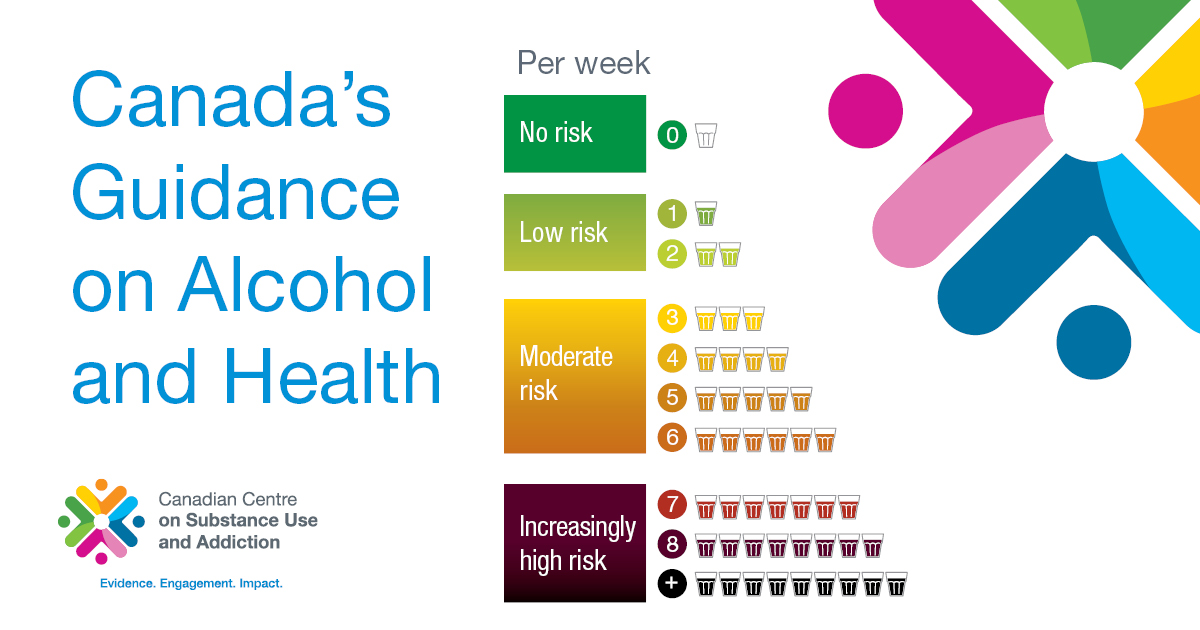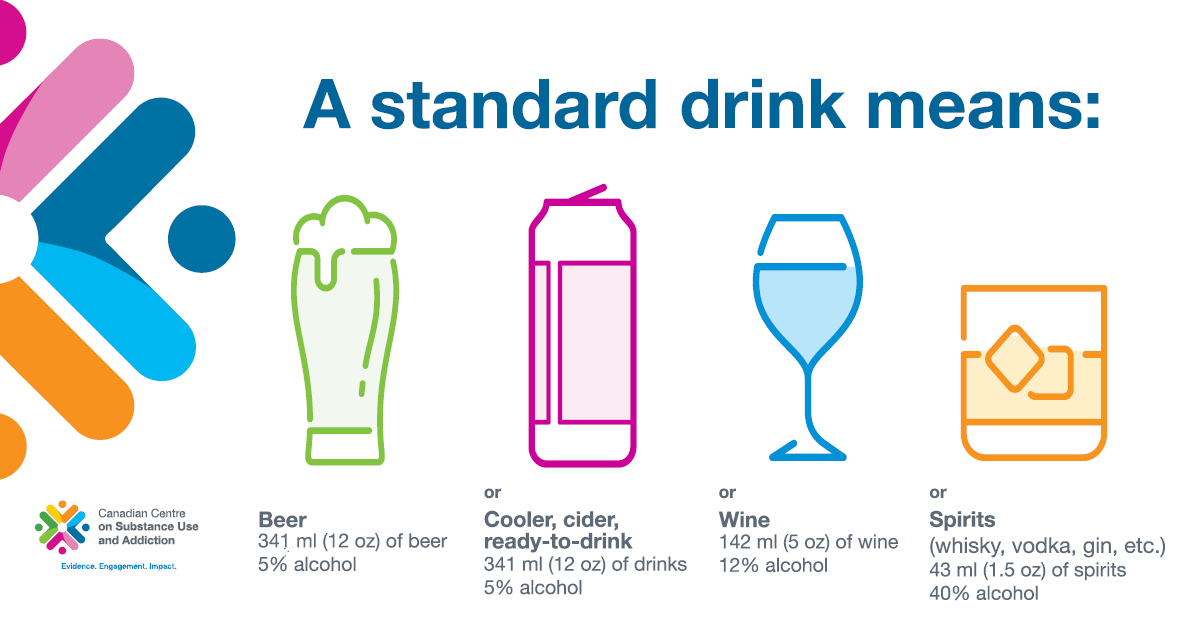Healthy People
Reducing alcohol consumption is an important for step towards achieving good health.
Guidance on Alcohol and Health
In January 2023, new Canadian Guidance on Alcohol and Health was released by the Canadian Centre on Substance Use and Addiction (CCSA).
Key points from the new guidance include:
- All alcohol risk comes with risk
- The more alcohol you drink per week, the greater your risk of developing certain cancers, heart disease, stroke and other alcohol-related harms.
- Any reduction in the alcohol you consume per week has benefits.
- No matter where you are on the continuum, for your health, less alcohol is better.
- What is a standard drink size?
-
Although alcohol comes in many different forms, it still has the same effects when consumed. Standard drink sizes are therefore used to account for the percentage of alcohol by volume. In the following diagram, each standard drink contains 13.6 grams of alcohol.
- When is zero the limit?
-
- When pregnant or trying to get pregnant, there is no known safe amount of alcohol use.
- When breastfeeding, not drinking alcohol is safest.
- Alcohol should not be consumed with other substances.
- Alcohol should not be consumed when taking medication that interact with alcohol.
- Alcohol should not be consumed when playing sports or engaging in dangerous physical activities.
- Alcohol should not be consumed when driving a motor vehicle or using machinery.
- Zero alcohol is safest for those living with alcohol dependence.
- Less Is Best Campaign
-
In November 2023, the Chief Public Health Office launched a provincial campaign to raise awareness about the new Canadian Guidance on Alcohol and Health.
More information on the campaign and resources can be found here.
Health and Social Risks
Alcohol has harmful impacts on individuals, households, communities, and society, yet it is a normalized part of our culture and everyday conversations. Compared to other substances such as cannabis or opioids, the harms created by alcohol are often less known or ignored.
Alcohol affects every person differently depending on things like gender, size, when you last ate, and many more.
- Short-term risks
-
Short-term effects of consuming alcohol vary but can include:
- Altered mood, energy levels, concentration and memory
- Altered judgment and movement, impaired muscle control and vision, slurred speech, nausea and vomiting, headaches, drowsiness
- Difficulty breathing and can even be the cause of coma or death
- An interrupted sleep, which can in turn have a negative impact on your mental well-being
- Increased risk of injury and/or exposure to violence
- Increased feelings of anxiety and/or depression
- Unconsciousness and/or blackouts (memory lapses)
- Long-term risks
-
Long-term, alcohol can have serious effects on both our brain and body and can cause:
- Ongoing mental health conditions
- An increased risk of type 2 diabetes and weight gain
- Increased risk of a range of cancers and diseases, such as liver, breast and colorectal cancers, stroke, etc.
- Heart issues, such as high blood pressure, heart damage and heart attacks
- Liver failure
- Brain-related damage and impairment
- Fertility issues
- Lost productivity
- Loss of social connections
- Alcohol & Cancer
-
Globally, alcohol is one of the top three causes of cancer deaths. In Canada, alcohol was linked to 7,000 new cancer cases in 2020 alone.
Most Canadians are not aware that alcohol can cause cancer. Evidence shows that the more informed the public and consumers are, the more they will support alcohol policies to protect their health. Strong health messages, including warning labels on alcohol products, can help to shift drinking behaviours.
Reducing your alcohol consumption will help to reduce your risk of developing certain cancers.
- FASD
-
Fetal Alcohol Spectrum Disorder (FASD) is a diagnostic term used to describe impacts of the brain and body to individuals prenatally exposed to alcohol. FASD is a lifelong disability. Individuals with FASD may experience some degree of challenges in their daily living, and need support with motor skills, physical health, learning, memory, attention, communication, emotional regulation, and social skills.
FASD is one of the leading developmental disabilities in Canada and affects an estimated 1.6 million Canadians (more than autism and cerebral palsy, for e.g.).
There is no safe amount of alcohol or time for alcohol use during pregnancy.
- Pregnant or planning to be pregnant
- Driving or using machinery
- Taking medicine or drugs that interact with alcohol
- Living with mental or physical health problems
- Living with alcohol dependence
- Playing sports or engaging in dangerous physical activities





